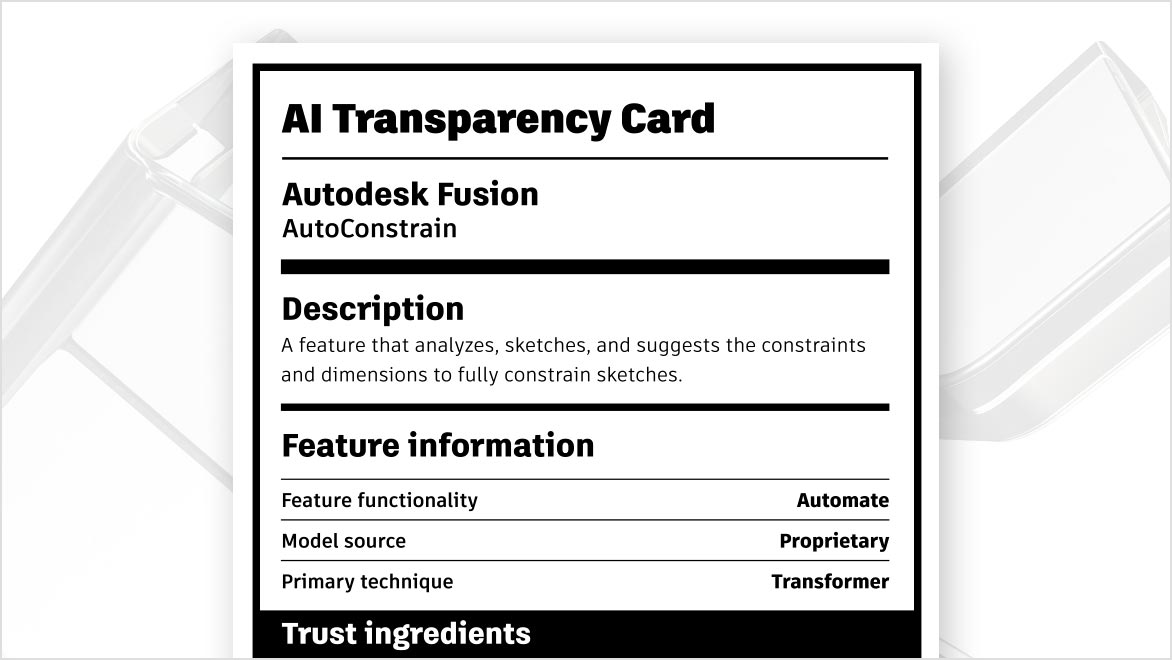& Construction

Integrated BIM tools, including Revit, AutoCAD, and Civil 3D
& Manufacturing

Professional CAD/CAM tools built on Inventor and AutoCAD
Autodesk is committed to responsible, ethical, and secure AI development, deployment, and use. We adhere to strict governance processes to protect our customers’ personal data and intellectual property. We implement responsible testing and monitoring practices throughout the AI lifecycle to mitigate or avoid instances where our AI might perpetuate biases, amplify social challenges, or lead to new avenues of risk.
We adhere to high standards in acquiring and managing data, and in training and delivering fair and safe AI models.
We are forthcoming about the design, development, and intended use of AI systems and data.
We respect our customers’ choices and align to laws and regulations.
We are rigorous in building AI systems that strive to provide accuracy, validity, and consistency.
We are committed to protecting data, intellectual property, and privacy, and producing safe outcomes.
As part of our ongoing commitment to delivering trusted AI, we have developed AI transparency cards to disclose information about the AI features used in our products. These cards provide details on feature functionality, data sources, and the privacy and security safeguards in place.
AutoConstrain
The Fusion AutoConstrain feature analyzes sketches and suggests the constraints and dimensions to fully constrain sketches.
Fastener Classification for Drawing Automation
The Fusion Fastener Classification for Drawing Automation feature detects, classifies, and omits fasteners from drawings to improve efficiency of drawing creation.
Machine Learning Deformer
The Maya Machine Learning Deformer feature approximates complex character deformation with something fast and interactive.
Generative Design in Revit
The Revit Generative Design in Revit feature works with one or more outputs in tension to evolve a Design study by providing a series of results that are optimal but have trade-offs.
ML Node Autocomplete
The Dynamo ML Mode Autocomplete feature takes a node input and recommends upstream or downstream nodes in a hierarchically ranked set of results.
Project Bernini Research
The Autodesk Research Project Bernini Research model generates functional 3D shapes from a variety of inputs including 2D images, text, voxels, and point clouds.
Autodesk has voluntarily committed to the EU AI Pact, which encourages and supports organizations to plan ahead for the implementation of AI Act measures across the EU.
Autodesk’s Trusted AI program is responsible for our Trusted AI principles and practices, as well as our collaboration with government and industry groups working toward responsible AI.
Autodesk’s Trust Organization, led by the Chief Trust Officer, implements and continuously reviews guidelines and processes to evaluate and mitigate AI risks. We regularly assess industry practices, standards, and emerging trends to foster responsible AI development and use in alignment with global AI, intellectual property, data protection, and privacy laws and regulations.
Autodesk is collaborating with the National Institute of Standards and Technology (NIST) in the Artificial Intelligence Safety Institute Consortium to develop science-based and empirically backed guidelines and standards for AI measurement and policy, laying the foundation for AI safety across the world.
Autodesk is an active member of the Content Authenticity Initiative (CAI), which works to create a secure system for digital content provenance and media transparency. The work we do within CAI is fully compliant with the technical specifications released in 2022 by the Coalition for Content Provenance and Authenticity (C2PA) or C2PA Content Credentials.
Autodesk regularly solicits customer feedback to understand current sentiments on AI, including concerns, challenges, expectations, and requirements around the ethics and use of AI within Autodesk’s platform. See what they have to say.
Get details on all the information we share about our AI features.
Our AI transparency cards provide details on functionality, data sources, and the privacy and security safeguards in place for the artificial intelligence features used in our products.
The name of the Autodesk product and the name of the AI feature are presented at the top of the card, below the verbiage “AI Transparency Card.”
The card description summarizes the actions the AI feature is expected to perform when used within the product.
Feature functionality describes the AI and/or machine learning (ML) technology capabilities that enhance the AI feature using one of the following three terms:
The model source describes the source type from which the model was developed to power the AI feature:
The models behind each AI feature use methods, approaches, and techniques to learn from data, find patterns, perform tasks, and produce outcomes. We use techniques that will improve the quality and value of our products for customers. Techniques are constantly evolving, and in some cases multiple techniques are used, some of which may not be listed here. This field describes the primary technique used to develop the AI feature:
Indicated with a "yes" or "no" designation, this describes whether the generated output can be reviewed and/or further updated by the user before any final action is being taken. This is otherwise known as "human in the loop."
This section indicates whether personal data is present in the training, testing, or validation datasets used for the development of this feature.
The data source designation listed in the card identifies the types of data sources used for the development of this feature. This includes the data that was used to train the model that powers the AI feature. The types of sources are categorized as follows:
Choice formats are indicated as Opt-in/Opt-out, No, or N/A. These labels identify the form of choice available to customers and/or their users when their data is used for the AI feature's development/improvement.
We provide information about two types of encryption: encryption at rest, and encryption in transit. Both of these are shown with Yes or No designations.
This section of the card indicates, as applicable, what other notable mechanisms are employed to preserve the confidentiality and protection of the data in addition to our standard security mechanisms. These safeguards apply to both personal data and company data.
Report suspicious activity, malware, a data concern, or other security incident regarding an Autodesk product or service.
Reduce your risks of malware exposure and software failure by using genuine Autodesk software built by Autodesk.
Are you experiencing an outage with an Autodesk product or service? Check the real-time status of your cloud services.
Help us improve product security by reporting remote code execution, authentication bypass, or other vulnerabilities.




